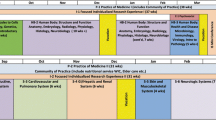Abstract
While clinical exams using SPs are used extensively across the medical schools for summative purposes and high-stakes decisions, the method of identifying students for remediation varies widely and there is a lack of consensus on the best methodological approach. The purpose of this study is to provide an alternative approach to identification of students for remediation using the latent class analysis (LCA) technique. 147 third year medical students participating in the Clinical Performance Examination (CPX) are included in the study. We used LCA to identify students who potentially need remediation based on their performance on CPX. Three distinct clusters of students with different performance profiles were identified. The identification of two rather than one low performing group has significant implications for identifying cut-points as well as for remediation programs. The two low performing groups in our study had low scores on contrasting sets of cases. LCA presents an alternative approach to identification of borderline or low performing groups. This method provides advantages over traditional statistical techniques such as cluster analysis used for grouping students. Based on the flexibility of the model specification, within the LCA framework, we were able to identify more than one group that may need remediation or instruction support.
Similar content being viewed by others
References
Adamo, G. (2003). Simulated and standardized patients in OSCEs: Achievement and challenges 1992–2003. Medical Teacher, 25, 262–270.
Boscardin, C. K., Muthen, B., Francis, D. J., & Baker, E. L. (2008). Early identification of reading difficulties using heterogeneous developmental trajectories. Journal of Educational Psychology, 100(1), 192–208.
Boulet, J. R., De Champlian, A. F., & McKinley, D. W. (2003). Setting defensible performance standards on OCSEs and standardized patient examinations. Medical Teacher, 25(3), 245–249.
Boursicot, K., Roberts, T., & Pell, R. (2006). Standard setting for clinical competence at graduation from medical school: Is it possible to achieve consensus? Advances in Health Sciences Education, 11, 173–183.
Elstein, A. S., Shulman, L. S., & Sprafka, S. A. (1978). Medical problem solving (pp. 292–294). Cambridge, Massachusetts: Harvard University Press.
Garrett, E. S., & Zeger, S. L. (2000). Latent class model diagnosis. Biometrics, 56, 1055–1067.
Hagenaars, J. A., & McCutcheon, A. L. (Eds.). (2002). Applied latent class analysis. New York: Cambridge University Press.
Hauer, K., Teherani, A., Kerr, K., O’Sullivan, P., & Irby, D. (2007). Student performance problems in medical school clinical skills assessments. Academic Medicine, 82, S69–S72.
Hauer, K., Teherani, A., Irby, D., Kerr, K., & O’Sullivan, P. (2008). Approaches to medical student remediation after a comprehensive clinical skills examination. Medical Education, 42(1), 104–112.
Hersen, M., & Thomas, J. C. (2006). Comprehensive handbook of personality and psychology. New Jersey: Wiley.
Kendler, K. S., Eaves, L. J., Walters, E. E., Neale, M. C., Heath, A. C., & Kessler, R. C. (1996). The identification and validation of distinct depressive syndromes in a population-based sample of female twins. Archives of General Psychiatry, 53, 391–399.
McLachlan, G., & Peel, D. (2000). Finite mixture models. New York: Wiley Interscience.
Muthén, B. (2000). Methodological issues in random coefficient growth modeling using a latent variable framework: Applications to the development of heavy drinking. In J. Rose, L. Chassin, C. Presson, & J. Sherman (Eds.), Multivariate applications in substance use research (pp. 113–140). Hillsdale, NJ: Erlbaum.
Norman, G., Bordage, G., Page, G., & Keane, D. (2006). How specific is case specificity? Medical Education, 40, 618–623.
Van Der Vleuten, C. P. M., & Swanson, D. B. (1990). Assessing clinical skills with standardised patients: The state of the art. Teaching and learning in medicine, 2, 58–76.
Vermunt, J. K., & Magidson, J. (2002). Latent class cluster analysis. In: J. A. Hagenaars, & A. L. McCutcheon (Eds.), Applied latent class analysis (pp. 89–106). Cambridge: Cambridge University Press.
Author information
Authors and Affiliations
Corresponding author
Rights and permissions
About this article
Cite this article
Boscardin, C.K. Profiling students for remediation using latent class analysis. Adv in Health Sci Educ 17, 55–63 (2012). https://doi.org/10.1007/s10459-011-9293-4
Received:
Accepted:
Published:
Issue Date:
DOI: https://doi.org/10.1007/s10459-011-9293-4




